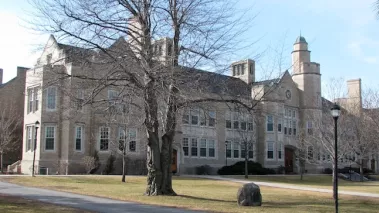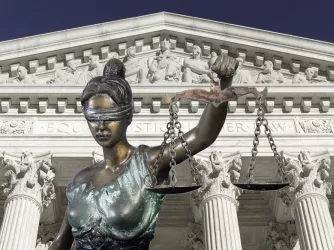Table of Contents
SUNY and OCR Reach Agreement on Sexual Misconduct Policies

Addressing concerns that State University of New York (SUNY) institutions were not responding adequately to sexual misconduct allegations, SUNY and the Department of Education’s Office for Civil Rights (OCR) entered into an agreement on September 30 setting forth changes SUNY will make to its policies and procedures.
In contrast to the University of Montana’s agreement with OCR and the Department of Justice in May—the “blueprint”—SUNY’s agreement sets forth a narrower definition of “sexual harassment,” and even increases some protections for accused students. But as Brooklyn College professor KC Johnson pointed out in Minding the Campus last week, some provisions of the agreement may endanger students’ due process rights.
OCR’s findings letter regarding SUNY, issued October 31, states:
Sexual harassment that creates a hostile environment is a form of sex discrimination prohibited by Title IX. Sexual harassment is unwelcome conduct of a sexual nature. Sexual harassment can include unwelcome sexual advances; requests for sexual favors; and other verbal, nonverbal, or physical conduct of a sexual nature, such as sexual assault or acts of sexual violence. Sexual harassment of a student creates a hostile environment if the conduct is sufficiently serious that it denies or limits a student’s ability to participate in or benefit from the recipient’s program.
In determining whether this denial or limitation has occurred, the United States examines all the relevant circumstances from an objective and subjective perspective, including: the type of harassment (e.g., whether it was verbal or physical); the frequency and severity of the conduct; the age, sex, and relationship of the individuals involved (e.g., teacher-student or student-student); the setting and context in which the harassment occurred; whether other incidents have occurred at the college or university; and other relevant factors.
As an initial matter, this discussion of sexual harassment fails to meet the standard set forth by the Supreme Court in Davis v. Monroe County Board of Education, 526 U.S. 629 (1999): Actionable sexual harassment is targeted, discriminatory conduct that is “so severe, pervasive, and objectively offensive that it can be said to deprive the victims of access to the educational opportunities or benefits provided by the school.” So OCR’s definition is again insufficiently precise and overly broad, as we’ve stated repeatedly in letters to OCR.
That said, the definition in the SUNY letter is an improvement over the blueprint. First, it’s functionally narrower than the blueprint’s definition (“any unwelcome conduct of a sexual nature”). Second, it makes clear that only conduct that constitutes hostile environment harassment is prohibited by Title IX and thus actionable—an important distinction that the blueprint essentially ignored. A footnote in the SUNY findings letter states that for all purposes relevant to OCR’s jurisdiction and Title IX compliance, student-on-student sexual harassment is sexual harassment that creates a hostile environment: “References to ‘sexual harassment’ described in the SUNY System procedures hereafter refer to ‘sexual harassment that creates a hostile environment.’” Relatedly—and most importantly—the SUNY findings letter does not mandate the verbatim adoption of the blueprint’s broad definition as controlling policy. That’s a significant difference, because it means that unlike the blueprint, the findings letter does not require that SUNY institutions prohibit protected speech.
The language in the SUNY findings letter tracks that contained in OCR’s 2001 Revised Sexual Harassment Guidance. Indeed, a footnote in the letter explicitly states that the “applicable legal standards described herein are more fully discussed” in the 2001 Guidance and in “Dear Colleague” letters from OCR in 2010 and 2011. So while sexual harassment is, descriptively speaking, “unwelcome conduct of a sexual nature,” it is not any such conduct, but instead only conduct that objectively and subjectively denies a student access to educational benefits. And given the substantive ways the blueprint broke with the 2001Guidance, this similarity represents an improvement, even just by seemingly restoring the status quo.
SUNY’s and OCR’s reference to pre-2013 OCR Guidance rather than the blueprint is perhaps surprising, considering SUNY associate counsel Andrea Stagg’s June column for Inside Higher Ed dismissing FIRE’s concerns with the blueprint. FIRE believes that policies concerning student-on-student sexual harassment should track the Davis standard, but the standards SUNY has agreed to pose less of a threat to protected speech than the blueprint.
In addition, while much of the findings letter and agreement with SUNY focuses on ensuring a swift investigation along with resources and remedial measures in order to protect the complainant, the agreement provides important fixes for accused students as well. For example, an investigation at SUNY Albany revealed that the school failed to “inform the accused of appeal rights even though the complainant was so informed.” SUNY’s steps to rectify these discrepancies between the procedural protections afforded both parties are critically important, particularly in light of the low “preponderance of the evidence” standard of proof OCR has mandated for determining responsibility in campus sexual misconduct hearings nationwide.
But SUNY’s agreement with OCR also allows for schools to investigate and hold disciplinary hearings even in cases where law enforcement officers—who are all but certainly better trained and equipped to investigate claims involving criminal conduct—have determined that there is insufficient evidence to move forward with a case. Johnson writes:
The consent agreement holds that not only must SUNY not rely on law enforcement agencies to investigate allegations—but that in instances where an accuser simultaneously files campus and criminal charges, SUNY must comprehensively investigate, even if it receives word that no criminal charges are filed. (SUNY, in fact, promises to “promptly resume [any] Title IX investigation as soon as notified by the law enforcement agency that it has completed the evidence gathering process.”) Under the consent agreement, therefore, SUNY is now obligated to independently investigate the (rare) cases in which police not only don’t pursue charges but charge an accuser with filing a false report. This might be deemed the “Caleb Warner Rule” (the North Dakota student deemed a rapist by his school even after police filed charges against his accuser), and suggests the possibility that SUNY could brand a student a rapist even if police had independently concluded his accuser was lying.
Johnson also noted that both the findings letter and agreement frequently refer to the complainant as the “victim,” rather than “alleged victim,” “accuser,” or “complainant.” This choice of language arguably erodes the presumption of innocence afforded the accused student.
The agreement will affect 29 SUNY schools including 219,000 students and 70,000 employees. (The agreement does not apply to SUNY’s community colleges.) SUNY spokesman David Doyle expressed a hope that SUNY campuses would be “national models for Title IX compliance and training.” Beyond SUNY schools, though, it’s difficult to predict what impact the agreement might have on other colleges and universities.
For now, the most important aspect of the SUNY agreement might be the fact that it departs from the “blueprint” announced just months ago. Following the changes from the blueprint reflected in the actual policy eventually adopted by the University of Montana itself, one might conclude that the most striking overreach articulated in the blueprint—mandating use of the broad definition of sexual harassment—has been more or less retracted by OCR. Time will tell—and FIRE will be watching.
Image: Hawkins Hall, SUNY Plattsburgh - Wikimedia Commons
Recent Articles
FIRE’s award-winning Newsdesk covers the free speech news you need to stay informed.

Supreme Court must halt unprecedented TikTok ban to allow review, FIRE argues in new brief to high court

Australia blocks social media for teens while UK mulls blasphemy ban

Free speech advocates converge to support FIRE’s ‘Let's Go Brandon’ federal court appeal
